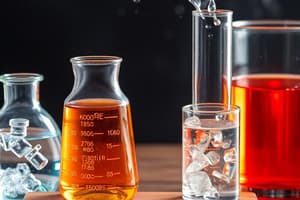Podcast
Questions and Answers
What is the main difference between endothermic and exothermic reactions?
What is the main difference between endothermic and exothermic reactions?
- Endothermic reactions release energy, while exothermic reactions absorb energy.
- Endothermic reactions release heat, while exothermic reactions absorb heat.
- Endothermic reactions absorb heat, while exothermic reactions release heat. (correct)
- Endothermic reactions don't require energy input, while exothermic reactions do.
Which of the following is an example of a chemical reaction in daily life?
Which of the following is an example of a chemical reaction in daily life?
- Boiling water
- Rusting of an old car (correct)
- Turning the pages of a book
- Turning on a light switch
What type of reaction involves constructing new compounds by combining existing materials?
What type of reaction involves constructing new compounds by combining existing materials?
- Combustion
- Decomposition
- Single displacement
- Synthesis (correct)
Which of the following is an example of decomposition?
Which of the following is an example of decomposition?
In which type of reaction, heat is released into the surroundings as the reaction progresses?
In which type of reaction, heat is released into the surroundings as the reaction progresses?
What type of reaction is most likely to involve a transfer of electrons between reactants?
What type of reaction is most likely to involve a transfer of electrons between reactants?
When vinegar is mixed with baking soda, what type of reaction occurs?
When vinegar is mixed with baking soda, what type of reaction occurs?
Which type of reaction typically produces salts and water as products?
Which type of reaction typically produces salts and water as products?
What might be a noticeable indication of a chemical reaction occurring?
What might be a noticeable indication of a chemical reaction occurring?
Adding calcium chloride to excess ammonia results in the formation of what products?
Adding calcium chloride to excess ammonia results in the formation of what products?
Flashcards are hidden until you start studying
Study Notes
Understanding Chemical Reactions
Chemical reactions involve the transformation of substances—called reactants—into entirely distinct substances—the resulting products. As atoms rearrange themselves, bonds break and form, leading to enduring changes that manifest through various forms and functions.
Endothermic and Exothermic Reactions
Endothermic reactions absorb heat from their surroundings, requiring input energy to proceed. Contrastingly, exothermic reactions discharge heat into their environments, releasing energy in the progression of the reaction.
Chemical Reactions in Daily Life
From cooking to breathing, daily life teems with myriad chemical reactions that sustain our existence, shaping the very fabric of our world. Take, for instance, the rusting of an old car, the browning of bread, or the fermentation required for winemaking.
Classifying Reactions
While there are numerous classification schemes for chemical reactions, knowing just a handful enables us to grasp fundamental principles and anticipate trends. Here are some exemplars:
Synthesis
Synthesis involves constructing new compounds via the combination of existing materials. For example, burning methane (CH₄) and oxygen (O₂) creates carbon dioxide (CO₂) and water (H₂O).
Decomposition
Decomposition breaks apart larger molecules into simpler components. This process is commonly seen in the decay of food or the conversion of salt (NaCl) into sodium (Na⁺) and chloride (Cl⁻) ions.
Reduction-Oxidation Reactions (Redox)
These reactions involve a transfer of electrons between reactants, altering their respective oxidation states. One familiar example is electrolysis, wherein copper (Cu²⁺) reduces to metallic copper (Cu) while oxygen (O₂) oxidizes to O²⁻ ions.
Acid-Base Reactions
Also known as neutralization reactions, these interactions occur between acids and bases, yielding salts and water. Vinegar mixed with baking soda produces carbon dioxide and a solution containing sodium acetate (CH₃COONa).
Double Displacement (Precipitation) Reactions
Occurring when ionic compounds exchange their cations and anions, creating insoluble products and soluble leftovers. For example, adding calcium chloride (CaCl₂) to excess ammonia (NH₃), producing insoluble calcium carbonate (CaCO₃) and soluble ammonium chloride (NH₄Cl).
Noticeable Indications of Reactions
Certain indicators signal the occurrence of chemical reactions, such as temperature shifts, light emission, or the creation of new phases or substances. Additionally, mass may change due to significant separation of reactants or products, often expressed via stoichiometry.
Regardless of scale, chemical reactions represent ubiquitous, dynamic phenomena that shape our lives and world in countless ways. Appreciating their behaviors sheds valuable insight into the natural universe we inhabit.
Studying That Suits You
Use AI to generate personalized quizzes and flashcards to suit your learning preferences.




